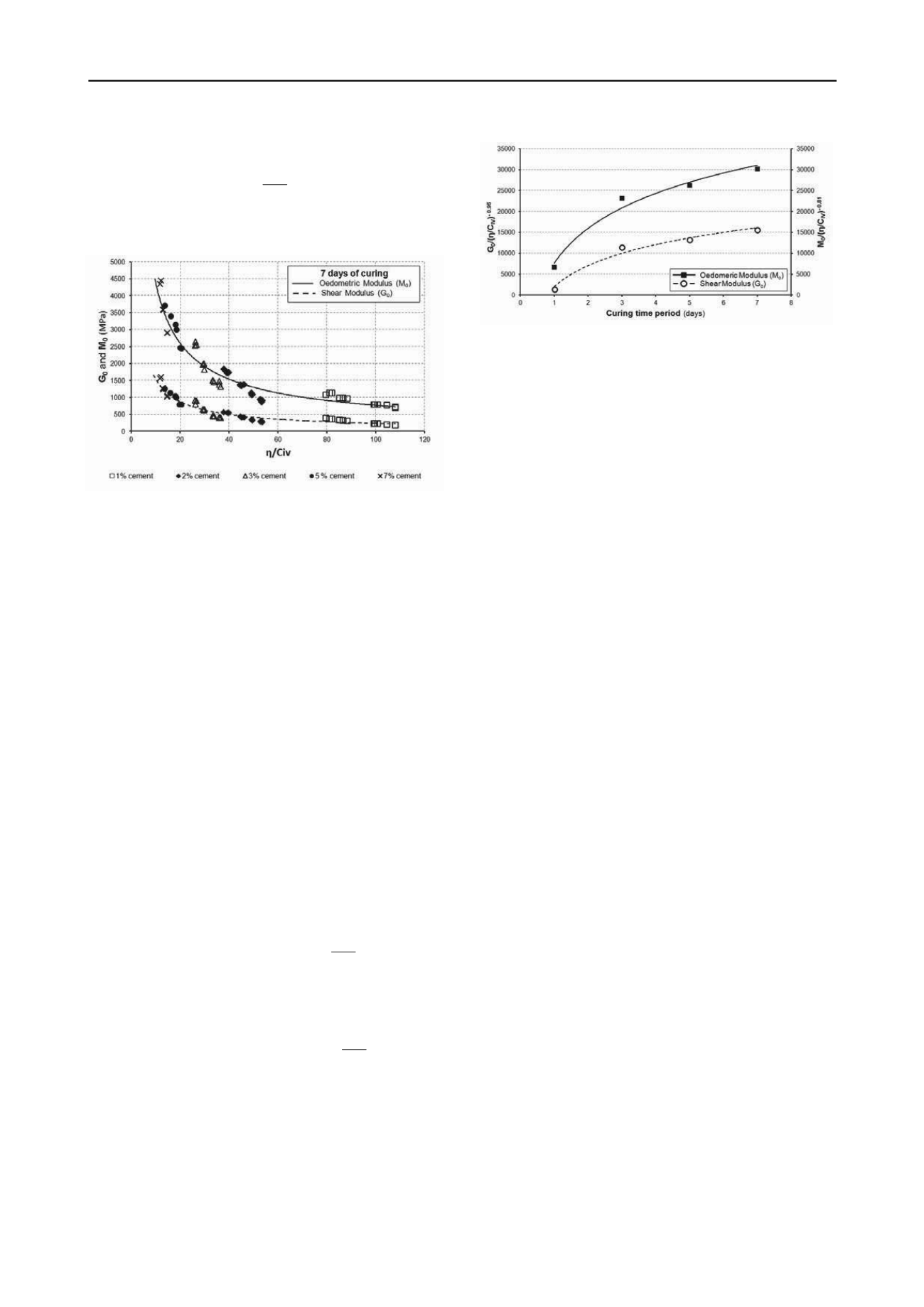
324
Proceedings of the 18
th
International Conference on Soil Mechanics and Geotechnical Engineering, Paris 2013
Proceedings of the 18
th
International Conference on Soil Mechanics and Geotechnical Engineering, Paris 2013
81.0
7
220 ,30 )
(
iv
days
o
C
MPa
M
(10)
Figure 6. Increasing shear (G
o
) and oedometric (M
o
) moduli with curing
time period.
4 CONCLUSIONS
From the data presented in this manuscript the following
conclusions can be drawn:
Figure 5. Shear (G
o
) and oedometric (M
o
) moduli at seven days of
curing.
So, the use of the porosity of the compacted mixture divided
by the volumetric cement content to assess both shear (G
o
) and
oedometric (M
o
) moduli in the soil-cement mixtures studied
herein is valid for all curing time periods studied. The results
presented in this manuscript therefore suggest that using the
porosity/cement ratio as represented by the porosity of the
compacted mixture divided by the volumetric cement content,
the engineer can choose the amount of cement and the porosity
appropriate (within the studied range) to provide a mixture that
meets the stiffness required by the project at the optimum cost.
It can be seen from comparison of Eqs. (3), (5), (7) and (9) that
G
o
has a direct relationship with (
/C
iv
)
-0.95
for the all curing
time periods and only a scalar differs regarding the effect of
curing time. A similar situation is observed by comparing Eqs.
(4), (6), (8) and (10), showing that M
o
has a direct relationship
with (
/C
iv
)
-0.81
for the all curing time periods and only a scalar
differs regarding the effect of curing time. So, unique
relationships can be achieved linking the G
o
and M
o
with
, C
iv
and days of curing (
t
), as displayed in Fig. 6 and expressed
mathematically by Eqs. (11) and (12), respectively for G
o
and
M
o
. The coefficients of correlation are high [R
2
=0.98 and 0.97,
respectively for shear and oedometric modulus].
• The porosity/cement ratio (η/C
iv
) has been shown to be an
appropriate index parameter to assess the shear (G
o
) and
oedometric (M
o
) modulus in the sand-cement mixture studied
herein for all curing time periods studied. Unique relationships
were achieved linking the G
o
and M
o
with η, C
iv
and time of
curing (t);
• Based on the dosage equation established in present
research for the studied sand-cement mixtures, there are several
technical ways of reaching G
o
or M
o
target values for a given
project and the best solution might change from situation to
situation, depending on time period available, accessibility to
equipment to reach a given porosity and cost of cement.
3. ACKNOWLEDGEMENTS
The authors wish to express their gratitude to Brazilian
Research Council (CNPq) for the financial support to the
research group.
4. REFERENCES
Consoli N.C., Viana da Fonseca A., Cruz R.C. and Heineck K.S. 2009.
Fundamental parameters for the stiffness and strength control of
artificially cemented sand.
Journal of Geotechnical and
Geoenvironmental Engineering
135 (9), 1347-1353.
95.0
ln. 250 ,7 022 ,2 )
(
iv
t
o
C
t
MPa G
(11)
Consoli N.C., Cruz R.C., Floss M.F. and Festugato L. 2010. Parameters
controlling tensile and compressive strength of artificially cemented
sand.
Journal of Geotechnical and Geoenvironmental Engineering
136 (5), 759-763.
Consoli N.C., Cruz R.C. and Floss M.F. 2011. Variables controlling
strength of artificially cemented sand: Influence of curing time.
Journal of Materials in Civil Engineering
23 (5), 692-696.
Consoli N.C., Cruz R.C., Viana da Fonseca A. and Coop M.R. 2012a.
Parameters controlling stiffness and strength of artificially
cemented soils.
Géotechnique
62 (2), 177-183.
81.0
ln. 038 ,12 631 ,7 )
(
iv
t
o
C
t
MPa M
(12)
Consoli N.C., Viana da Fonseca A., Cruz R.C. and Heineck K.S. 2012b.
Influence of cement-voids ratio on stress-dilatancy behavior of
artificially cemented sand.
Journal of Geotechnical and
Geoenvironmental Engineering
138 (1), 100-109.
Mitchell J.K. 1981. Soil improvement—State-of-the-art report.
Proc.,
10th Int. Conf. Soil Mechanics and Foundation Engineering
,
International Society of Soil Mechanics and Foundation
Engineering, Stockholm, 4, 509–565.


